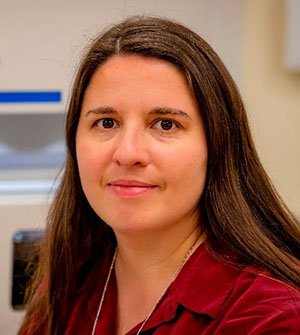Dr. Iryna Zenyuk seminar
Seminar title: "Realizing Hydrogen Economy and Rethinking Catalyst Layer Design: Interplay between Activity and Durability for Polymer Electrolyte Fuel Cells"
Abstract:
The U.S. has pledged to decarbonize its economy by 2050. Decarbonization of transportation sector is critical to achieve net-zero emissions economy by 2050. Department of Energy (DOE) has issued Hydrogen Shot aiming to produce 1 kg of hydrogen for $1 in 1 decade. This ‘111’ target is ambitious, as currently challenges of electrolyzers cost, durability and scale-up to MW scale need to be addressed. Once produced, hydrogen will be utilized in various industries, including manufacturing and it can serve as a fuel for various applications, including polymer electrolyte fuel cell (PEFCs). These technologies have advanced to reach the commercialization stage with more automotive manufacturers announcing new PEFC-based light and heavy-duty vehicles. The main advantage of the PEFCs is that they have zero emissions and produce only water. Using the DOE cost-breakdown for the 80-kWnet stack for light-duty vehicles, the cost of precious metal electrocatalysts remains almost unchanged as production rate increases to 0.5 M PEFC stacks per year. The cost of the electrocatalysts amounts to 31% of stack cost, for 0.5 M systems per year production rate. Platinum (Pt) or Pt-alloys are used as electrocatalysts for the oxygen reduction reaction (ORR) on the cathode side and the hydrogen oxidation reaction (HOR) on the anode side of PEFCs. Pt or Pt-alloy electrocatalysts are dispersed as nanoparticles onto a carbon-black support. DOE set a target of reducing Pt loading to 0.125 mg cm-2 to achieve the goal of $12.6 kWnet-1 for a stack with power density target of 1.8 W cm-2. Membrane electrode assemblies (MEAs) with lower catalyst loading are less durable [1], thus, the cost issue cannot be resolved without focusing on the catalyst durability issue of the PEFC stack. To reach the activity and durability targets, overall understanding of the interfaces within the MEAs are needed and their evolution during ageing.
This presentation will summarize my group’s recent efforts within the two main directions for the MEA design: 1) catalyst durability studies, via advanced characterization [2], 2) Pt-ionomer interface understanding during the PEFC lifetime and its impact on activity and durability. Using methodology of electrochemical characterization, including CO-displacement/stripping, double layer capacity studies, oxygen transport resistance measurements, and others, along with the computational modeling and advanced material characterization (synchrotron and lab-scale), we aim to build comprehensive understanding of transport properties, water management and interfacial properties during the PEFCs’ lifetime.
References:
- G. S. Harzer, J. N. Schwämmlein, A. M. Damjanović, S. Ghosh, H. A. Gasteiger, J. Electrochem. Soc. 2018, 165, F3118–F3131.
- L. Cheng, K. Khedekar, M. Rezaei Talarposhti, A. Perego, M. Metzger, S. Kuppan, S. Stewart, P. Atanassov, N. Tamura, N. Craig, et al., Adv. Energy Mater. 2020, 2000623, 1–7.
- A. Avid and I.V. Zenyuk, Current Opinion in Electrochemistry, 2020, 25, 100634
Bio:
Iryna Zenyuk is an Associate Professor, Chemical and Biomolecular Engineering, University of California Irvine.
Professor Zenyuk holds a B.S. (2008) in mechanical engineering from the New York University Tandon School of Engineering. She continued her studies at Carnegie Mellon University, where she earned M.S. (2011) and Ph.D. (2013) in mechanical engineering. Her graduate work focused on fundamental understanding of electric double layers in electrochemical energy-conversion systems. After a postdoctoral fellowship at Lawrence Berkeley National Laboratory in Electrochemical Technologies Group, Zenyuk joined the faculty of the Mechanical Engineering Department at Tufts University in 2015. In July 2018 she joined Department of Chemical and Biomolecular Engineering at University of California, Irvine, where she is also a Director of the National Fuel Cell Research Center.
At UC Irvine, Zenyuk’s group works on enabling energy solutions by researching low-temperature hydrogen fuel-cells, Li-metal batteries and electrolyzers. Zenyuk works on design strategy encompassing novel materials, diagnostic tools and device-level testing.
She is a recipient of the NSF CAREER award (2017), Interpore society Fraunhofer Award for Young Researchers (2017), Research Corporation for Science Advancement, Scialog Fellow in Advanced Energy Storage (2017-2019), Electrochemical Society (ECS) Toyota Young Investigator Award (2018), UCI Samueli School of Engineering Early Career Faculty Excellence in Research Award (2019) and ECS Energy Technology Division Srinivasan Young Investigator Award (2021), UCI Beal Applied Innovations Early Career Innovator of the Year (2021), UCI Samueli School of Engineering Mid Career Faculty Excellence in Research Award (2022). Prof. Zenyuk published over 80 journal publications and delivered more than 100 invited presentations on topics of energy conversion and storage.
Twitter handle: @muziolog
Webpage: https://faculty.sites.uci.edu/zenyuklab/
